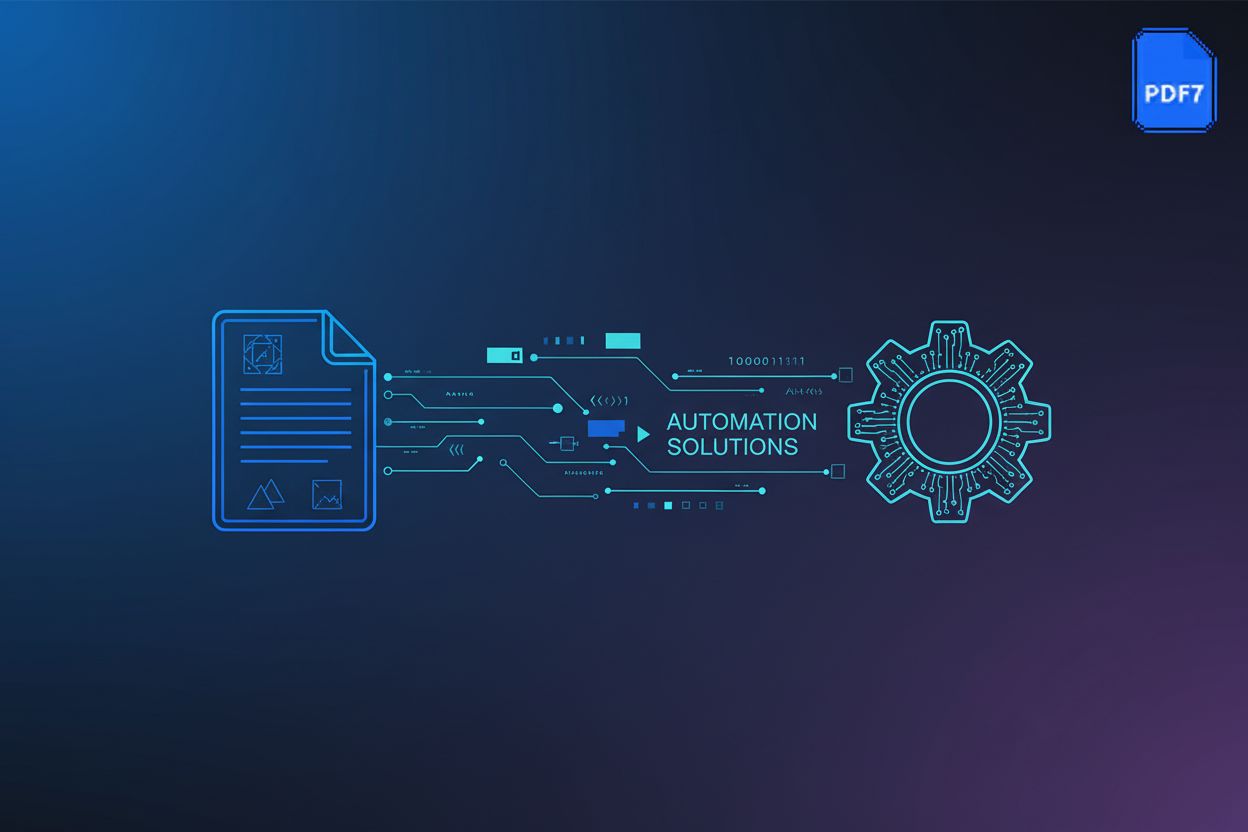Mastering PDF Form Field Recognition and Data Extraction: A Comprehensive Guide
Understanding PDF Forms and Their Importance
PDF forms are more than just digital copies of paper stuff; they're handy tools that make collecting and managing data way easier. But why are they so important nowadays with all the data flying around?
- Definition: PDF forms are interactive documents with fields you can actually fill out. (How to fill in PDF forms in Adobe Acrobat or Reader) These fields can be text boxes, checkboxes, radio buttons, dropdowns, and even places for digital signatures. They're great for collecting data in a structured way, which makes it simpler to process and analyze later.
- Types: There are mainly two kinds of PDF forms: AcroForms (the regular ones) and XFA forms (XML Form Architecture). AcroForms are pretty standard and easy to use, while XFA forms have more advanced, dynamic features but can be a bit trickier to work with everywhere. (Acroforms vs. XFA Forms) The difference matters for how we extract data; XFA forms, with their XML backbone and dynamic nature, often need different, more complex parsing strategies compared to the simpler structure of AcroForms.
- Interactive vs. Non-interactive: Interactive PDF forms have fields you can type into directly. Non-interactive forms are just static documents; you'd have to print them out and fill them by hand, which is way less efficient.
These benefits are realized across a wide range of industries, including:
Automation: Automating data entry cuts down a ton of manual work. Instead of typing info from PDFs into databases yourself, form field recognition and data extraction tools can just grab the data automatically, saving you time and effort.
Accuracy: These tools help reduce those annoying mistakes that happen with manual data entry. By accurately spotting and pulling data, you get more consistent and reliable information, which is super important for staying compliant and making smart decisions.
Efficiency: Making document workflows smoother just makes everything more efficient. Whether it's HR, finance, legal, or operations, getting to structured data quickly speeds things up and avoids those frustrating slowdowns.
Analysis: Once you've got the data from PDF forms, you can really dig into it for analysis and reports. This data can be plugged into business intelligence tools, giving you valuable insights for planning and seeing how things are going.
Finance: Speeding up how invoices get processed, automating financial reports, and making sure you're following all the rules.
Healthcare: Pulling patient info from medical records, automating insurance claims, and making data easier for doctors and nurses to access.
Legal: Making contract management smoother, processing legal papers, and helping with e-discovery.
Government: Automating application processes, managing public records, and improving how you serve citizens.
Education: Handling student enrollment forms, automating grading for tests, and making administrative tasks easier.
So, understanding PDF forms and why they matter is a good starting point for getting into form field recognition and data extraction, which is what we'll cover next.
Techniques for PDF Form Field Recognition
Ready to get into the nitty-gritty of how PDF form fields get recognized? Let's look at the different ways we can pull data out of PDFs, turning those static documents into useful, structured information.
Rule-based recognition is a basic method that uses pre-set rules to find form fields. Think of it like teaching a computer to "read" a PDF based on its structure and how it's put together.
- Defining Rules: This means setting specific conditions based on the PDF's internal makeup. For example, a rule might say that any text box right under text that says "Name:" is a name field.
- Identifying Fields: The system scans the PDF, looking for keywords like "Address," "Date," or "Signature" and where they are on the page. It then checks the type of object, like text boxes or checkboxes, to pinpoint the form fields.
- Limitations: Rule-based systems are pretty inflexible. They have trouble with forms that look a bit different, wording that's slightly changed, or even just weird formatting. This makes them not so great for documents that vary a lot or aren't structured neatly.
OCR comes in to help with PDFs that are basically images of text. By turning scanned text into actual, editable text, OCR makes form field recognition more flexible.
- Extracting Text: OCR algorithms look at the PDF and pull out the text from form field labels. This helps the system understand what each field is for.
- Preprocessing: To make OCR work better, we do things like cleaning up noise, sharpening images, and adjusting contrast. These steps give the OCR engine a clearer picture to work with.
- Identifying Field Names: OCR helps figure out field names and guess what kind of data they hold (like, a field called "Phone Number" is probably for numbers).
- Challenges: OCR can struggle with bad image quality, different fonts, and multiple languages in one document. But, OCR tech is getting better all the time, improving its accuracy and what it can do.
ai and machine learning are the most advanced ways to recognize PDF form fields. These methods use data and algorithms to "learn" how to find form fields, even in complicated or unstructured documents.
- Machine Learning Models: ai models are trained on tons of labeled PDF forms. These models learn to spot patterns and features that are common to different kinds of form fields.
- Training Data: The more data a model is trained on, the more accurate and reliable it gets. Labeled datasets show the model what different form fields look like and how they're usually arranged.
- Deep Learning: Deep learning, a type of machine learning, uses neural networks with many layers to analyze data. This allows for more complex pattern recognition and better accuracy in finding form fields.
- Adaptability: ai-powered systems can adjust to different form layouts and handle unstructured data better than rule-based or OCR-heavy methods. They can also "learn" from new forms, getting better over time.
- Example: Text Processing ai: Text Processing ai can be used to find and categorize form fields based on the surrounding text. For instance, if a block of text usually comes before a date field, the ai learns to recognize this pattern.
These techniques give us a powerful and flexible way to recognize PDF form fields. Next, we'll look at how to actually extract data using these techniques.
Data Extraction Methods from PDF Forms
Extracting data from PDF forms can be done in several effective ways, each suited for different kinds of forms and data needs. Let's check out the most common and advanced methods for getting valuable info out of your PDF documents.
Interactive PDF forms, the ones with fillable fields, offer a pretty direct way to get data. Using PDF processing libraries, you can directly access the values stored in these fields.
- Accessing Form Field Values: Libraries like PDFMiner, PyPDF2 (for Python), and iText (for Java) let you programmatically get to form field values. This method is super accurate because it gets the data exactly as the user entered it.
- Handling Different Data Types: These libraries can tell the difference between various data types, like text, numbers, dates, and checkboxes. This makes sure the extracted data is understood and formatted correctly for later use.
- Validating Extracted Data: You can set up checks to make sure the extracted data fits certain formats and rules. For example, making sure a phone number field has the right number of digits or that a date field is in the correct format.
Regular expressions (regex) are a flexible way to extract data from PDFs by finding specific patterns. This is especially useful when you have semi-structured data or when interactive form fields aren't available.
- Defining Regex Patterns: You create patterns to match specific data formats. For example, a regex pattern can be made to pull out phone numbers, email addresses, or dates from the text in a PDF.
- Applying Regex: The regex pattern is used on the PDF's text, finding and extracting any strings that match what you're looking for. This can be done using different programming languages and their regex libraries.
- Limitations: Regex can have a hard time with complex or unstructured data. If the data format changes a lot, creating one reliable regex pattern can be tough.
For the trickiest data extraction jobs, Artificial Intelligence (ai) and Natural Language Processing (nlp) offer powerful solutions. These techniques let you understand the meaning of form content, so you can extract data even from unstructured or semi-structured forms.
- Employing nlp Techniques: nlp helps understand the context and meaning of the text in the PDF. This lets the system accurately find and extract relevant information, even if it's not clearly labeled.
- Using Named Entity Recognition (NER): NER can find and categorize important info like names, places, and organizations. This is really helpful when dealing with forms that have inconsistent layouts.
- Applying Relationship Extraction: Relationship extraction finds connections between different form fields. For example, figuring out that a specific address belongs to a particular name on the form.
- Benefits of ai: ai is especially good for unstructured or semi-structured forms, where older methods like rule-based recognition and regex might not work well.
These data extraction methods give you the tools to unlock the information hidden in PDF forms. In the next section, we'll look at how to deal with common problems you might run into.
Tools and Libraries for PDF Form Processing
Did you know the right tools can make or break how well your PDF form processing works? Picking the right tools and libraries is key for efficient and accurate data extraction.
Open-source PDF libraries are a budget-friendly and customizable option for processing PDF forms. These libraries are maintained by developer communities, meaning they're always getting better and have lots of features.
- PDFMiner is a Python library that's great at pulling text from PDF documents. It can parse and analyze PDFs, making it useful for finding form fields and their content.
- PyPDF2, another Python library, lets you mess with PDF files, like combining, splitting, and getting data from interactive forms. Its flexibility makes it a popular choice for automating PDF tasks.
- Apache PDFBox is a Java library that offers a bunch of PDF processing capabilities. It can create, change, and extract content from PDF documents, including form fields and annotations.
Commercial PDF processing tools offer advanced features and dedicated support, making them a good choice for companies that need solid solutions. While they cost money to license, they often provide a more user-friendly experience and better functionality.
- Adobe Acrobat is a complete PDF solution with advanced OCR (Optical Character Recognition) and form field recognition. It lets users create, edit, and extract data from PDF forms easily.
- PDFTron is a high-performance PDF SDK that has advanced features like OCR, form field recognition, and data extraction. It works with many programming languages and platforms, so it can fit into different development setups.
- iText is a Java and .NET library that offers extensive PDF processing, including filling forms, extracting data, and digital signatures. It's widely used in business applications for making and changing documents.
Cloud-based PDF processing services offer scalability, ease of use, and pre-trained models, making them an excellent choice for processing lots of documents. These services use the power of the cloud to provide efficient and cost-effective solutions.
- Google Cloud Document AI uses ai and machine learning to automatically pull data from PDF forms. It has pre-trained models for different document types, so you don't need to do as much custom development.
- Amazon Textract is a cloud-based OCR service that can accurately pull text and data from scanned documents and PDF forms. It works smoothly with other Amazon Web Services, offering a scalable and reliable solution.
- Microsoft Azure Form Recognizer uses machine learning to find and extract data from PDF forms, even those with different layouts and structures. It supports many form types, making it versatile for different business needs.
For instance, according to Publications | The Human Screenome Project, Screenomics is being used as an open-source platform to collect multimodal data from Android smartphones, showing the growing trend of data extraction and analysis in various fields.
Need to quickly merge your PDFs? Try PDF7's PDF Merger Tool for free! Streamline your document management with our easy-to-use online tool.
Picking the right tools and libraries can really affect how efficient and accurate your PDF form processing is. Next, we'll look at how to handle common problems you might face.
Best Practices for Accurate and Efficient Data Extraction
Getting accurate data extraction isn't just about the tools; it's about setting things up for success with careful planning and execution. By following these best practices, you'll not only get better quality extracted data but also make your whole document workflow smoother.
The starting point for accurate data extraction is the quality of your PDF documents. Making these documents better ensures your extraction tools can easily find form fields and text.
- Optimize for OCR: Before you run OCR, make sure your PDFs are optimized. This includes deskewing (fixing tilted pages) and rotating pages correctly. These initial steps can really improve how well OCR works.
- Improve Image Resolution: PDFs that are basically images often have low resolution. Making the images clearer and higher resolution can boost OCR performance.
- Remove Unnecessary Elements: Clutter can confuse OCR engines. Getting rid of extra graphics, annotations, or watermarks makes the document simpler and improves how well it's recognized.
Even with optimized documents, mistakes can happen with extracted data. Putting in validation and cleansing processes makes sure the data is reliable and correct.
- Validate Against Predefined Rules: Extracted data should be checked against rules. For example, make sure dates are in the right format (YYYY-MM-DD) and phone numbers have the correct number of digits.
- Cleanse for Consistency: Fix inconsistencies in data. Standardize abbreviations (like "St." to "Street") and correct common typos to make everything uniform.
- Handle Missing Data: Have a plan for missing or incomplete data. This could mean flagging records for someone to look at manually or using default values when appropriate.
PDFs come in all sorts of formats and versions, each with its own quirks. Dealing with these compatibility issues makes sure your extraction process works smoothly across different documents.
- AcroForms and XFA Forms: Be aware of the differences between AcroForms and XFA forms. While AcroForms are widely supported, XFA forms might need special tools.
- Adapt Extraction Techniques: Different form layouts need different extraction approaches. Using ai-powered systems that can "learn" from new forms can be especially helpful here.
By focusing on these best practices, you'll create a strong and dependable data extraction process. Next, we'll dive into how to fix common problems you might encounter.
Security and Compliance Considerations
Extracting data can expose sensitive information, so security is super important. How do you make sure data privacy and ethical handling are maintained during this process?
- Encryption is key for protecting PDF documents both when they're stored and when they're being sent.
- Put in strong access controls to limit who can see or extract data.
- Use secure data transfer protocols (like SFTP, HTTPS) to stop data from being intercepted.
- Regularly check security measures to find and fix any weak spots.
- Think about using data masking or redaction techniques to protect personally identifiable information (PII).
Data privacy rules affect how you extract data from PDFs.
- Follow GDPR, CCPA, and other relevant laws by understanding what they mean for you.
- Use data anonymization and pseudonymization to lower privacy risks.
- Create data retention policies to manage how long extracted data is kept.
Ethical data extraction means respecting people's privacy.
- Get consent when extracting personal data.
- Be transparent about how data is extracted.
- Avoid bias in data analysis and reporting.
Understanding these points helps ensure PDF form processing is secure and ethical. Let's look at troubleshooting common data extraction issues next.
Future Trends in PDF Form Processing
The future of PDF form processing is changing fast, thanks to tech advancements and the growing need for efficient data management. How can businesses stay ahead and use these new trends?
Expect ai and machine learning to really boost how accurate and fast form field recognition and data extraction are. ai algorithms can learn from huge amounts of data, adapting to different form layouts and even handwriting styles.
Text Processing ai, which we mentioned before, will get even smarter, understanding context and subtle meanings in unstructured data. This will lead to more reliable extraction from complex documents.
ai's ability to adapt will mean less manual work, further automating workflows in fields like finance, healthcare, and logistics.
PDF form processing will become more tightly woven into automated document workflows, making operations smoother across different departments. This includes seamless connections with cloud platforms and business systems.
Real-time data extraction and validation will make sure information is instantly available and correct, cutting down on errors and improving decision-making.
Better collaboration and data sharing will let teams work together more effectively, no matter where they are.
Cloud computing will offer scalable and affordable solutions for PDF processing, especially for companies dealing with lots of documents.
Serverless architectures will allow for on-demand data extraction, optimizing resource use and cutting down on infrastructure costs.
Cloud-based solutions will also improve document management and access, making it easier to store, find, and share information securely.
As technology keeps moving forward, mastering PDF form field recognition and data extraction will become even more important for companies wanting to optimize their workflows and get a competitive edge. By embracing these future trends, businesses can unlock the full potential of their digital documents.





